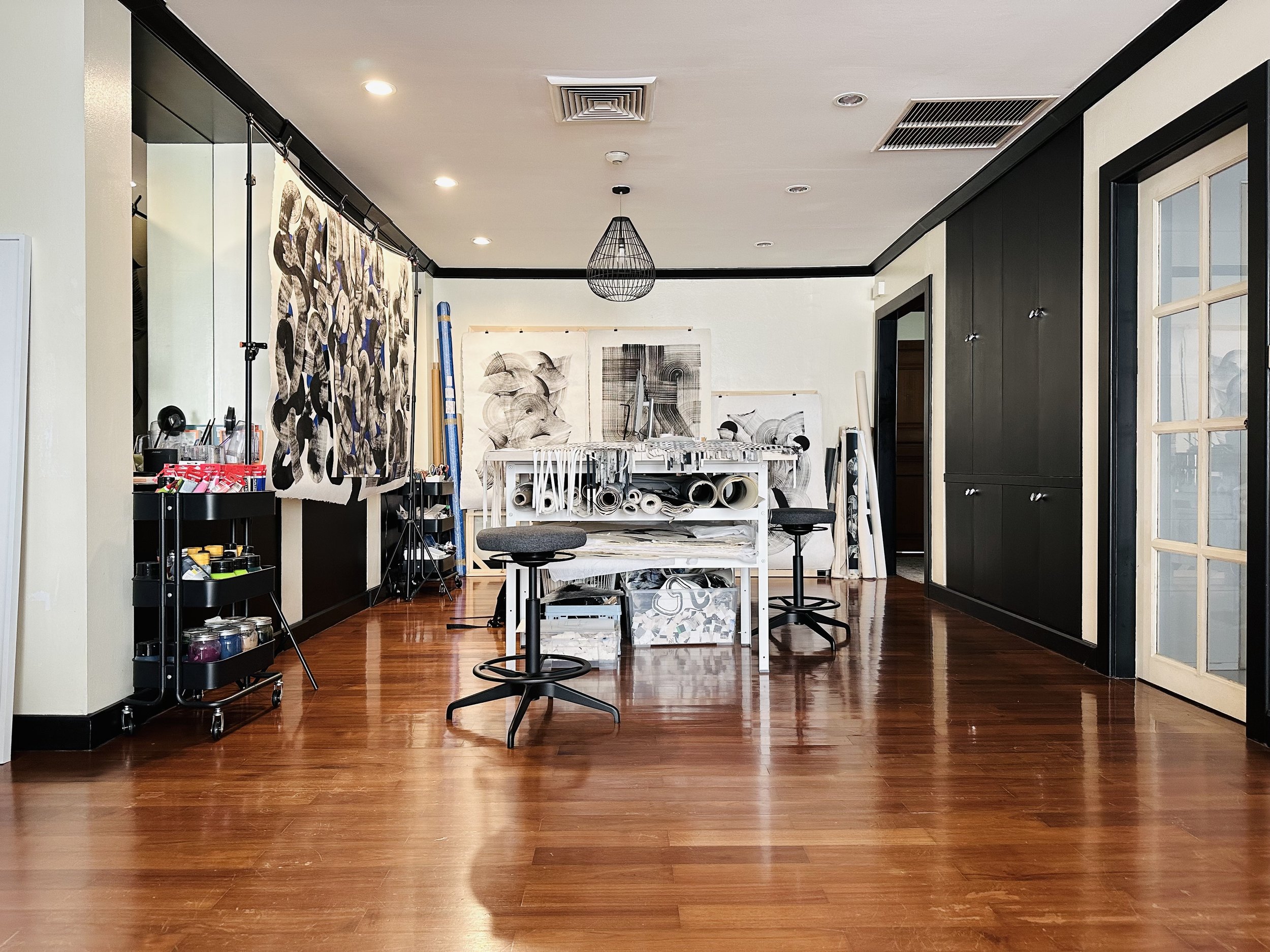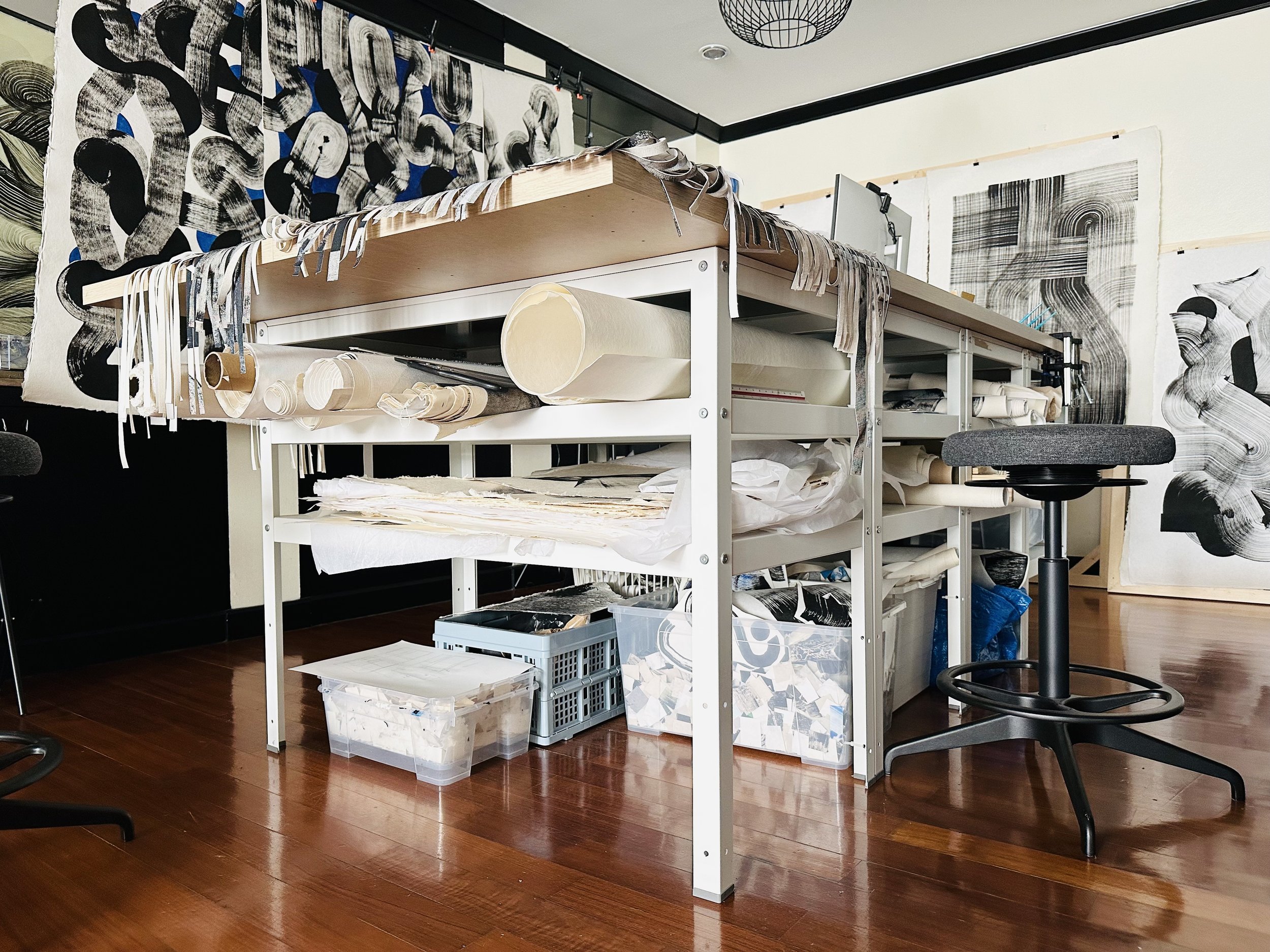Take a Look Inside My Home/Studio
Nestled on a lush, quiet street in Bangkok’s Sathon neighborhood, my Home and Studio is a slow, peaceful sanctuary within the beautifully energetic rush of the city.
Living and working in the same space can be a challenge, particularly for artists. Creating large format artwork within a limited or confined floor plan calls for creative solutions and flexibility. Working with messy mediums in a space that you may share with a partner and or children requires thoughtful planning, honest conversation, and compromise.
Making art in my own home has actually removed several roadblocks from my creative process. When inspiration arrives I can immediately get started and I spend my entire day immersed in my work.
Sathon, Bangkok
I live with my partner on the second floor of a gracefully-aged mid-rise building in Bangkok’s Sathon neighborhood. The building sits on a quiet, tree-lined street, although the towers of one of Bangkok’s many business clusters stand less than 500 meters away. When we found the unit in 2020, during the height of the pandemic, I was expanding my artistic practice and needed the extra space that this older building afforded.
Since moving in, building out the studio has been a constant experiment. Because our home is regularly visited by friends, family, colleagues, and clients, I’ve looked for ways to make my artwork visible and accessible without consuming too much space. It is important that visitors know that they are welcome to not only live amongst my art, but to ask questions and interact with the work.
Later in this post I will share some of the lessons I’ve learned while building my home/studio.
Using the Space
My work space occupies almost a third of our overall living space of 150sqm. I complete most of my large paintings on the floor or the wall. However, the centerpiece of the studio is a large table I’ve built from some standard Ikea parts.
I used 4 Ikea shelves and 3 table-tops to create a piece of furniture that can hold a large printer, long rolls of canvas, stacks of paper, and other supplies while supporting a large and open work surface. It’s simple but effective, and most importantly, upgradable.
Our second bedroom, always open for guests and visitors, doubles as art storage. When I’m drying handmade paper, I convert a small bathroom into a “drying room” using fans and a dehumidifier. The way I use the space is constantly changing but to maintain sanity within the household, the main bedroom is off-limits to my mess.
My work table pictured with rolls of canvas and recycled paper underneath and a weaving project hanging over the edge.
What I’ve learned while designing my home/studio:
Instead of building a home that is stylish or beautifully appointed, I’ve created one that is functional, cozy, and welcoming.
It doesn’t need to be “pretty”: It took me a while to get over the need to buy the most perfect office/studio furniture or to create a space that is instagram ready. I learned that the most important thing was that the space actually worked for me and my unique needs/ways of working.
Build a flexible space: The ability to move furniture around, or use it in different ways, is so important in a home studio. For instance, my large glass dining table turns into the perfect second work surface. Pushing my sofas around opens up large swaths of floor area for large paintings. Don’t be afraid to live with a new configuration for a week or two…or three if it helps with progress.
Show it: From tubes of paint stacked on a shelf to an incomplete canvas taped to the floor, show your work and show that the work space is active. Own the fact that you live amongst your work.
Let the space evolve: After lots of trial and error, I’ve created a storage strategy that works for me. The important note here is that you should experiment and iterate; You can commit to a configuration, live with it for a bit, make a change then repeat.
Make every surface count: I Like to work on multiple pieces at once and some of my artwork is quite large. So with limited space I use as many surfaces as I can to hold the work temporarily. I spread my canvas out across the floor or use the walls in my hallway and dining area. This takeover is temporary, but it gives me the freedom to start several pieces at once then prioritize a few that I’d like to focus on going forward.
Make space for others: Building on the previous point, if you are sharing the space (with a partner for example) ensure that your partner feels that they still have a place of their own free from your artistic chaos. Make sure they take the space they need and keep your clutter out of it!
Although I have rented a separate studio before, and I plan to do so again, having a well-tuned work space in my home is something I will always need to keep my artistic momentum going.
What about you?
What lessons have you learned while working from home?
How do you stay productive in a shared space?
If you’re an artist or creative like me, how do you keep your mess and clutter under control?
Feel free to leave questions and comments below!
-Trey











